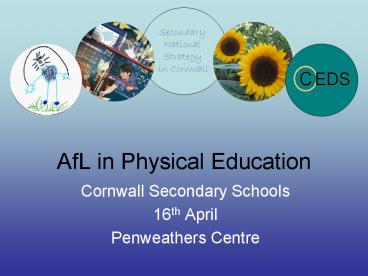AfL in Physical Education - PowerPoint PPT Presentation
1 / 33
Title:
AfL in Physical Education
Description:
suppleness, speed. IMPORTANT. ESSENTIAL. LESS IMPORTANT. STRENGTH. SPEED. STAMINA. SUPPLENESS. AGILITY. What is AfL? Independent learning ... – PowerPoint PPT presentation
Number of Views:73
Avg rating:3.0/5.0
Title: AfL in Physical Education
1
AfL in Physical Education
- Cornwall Secondary Schools
- 16th April
- Penweathers Centre
2
Objectives
- To define assessment for learning (AfL)
- To recognise key features of AfL
- To consider the impact of AfL on learners and
teachers - To identify strengths and areas of development in
our own practice - To consider AfL strategies that are most
applicable and relevant to PE
3
By the end of the session
- Professional learners will
- Be able to define AfL
- Be able to recognise key features of AfL in
practice - Be able to identify strengths in own practice and
at least one area for development - Know where to find out more about AfL in order to
pursue independent learning beyond what we have
covered today
4
Outline of the day
- 9-915 Register and coffee
- 915 Big Picture
- 940 What do you think AfL is?
- 950 What is AfL
- 1005 Active Engagement example 1
- 1015 Coffee
- 1040 Sharing learning objectives
- 1100 Feedback
- 1120 Lesson Observations
- 1150 Pupils Voice
- 1200 Teachers as learners
- 1220 Lunch
- 110 Success criteria
- 130 Questioning
- 145 Scenerios
- 205 Reflection on What is AfL
- 230-300 Action plan and evaluation
5
Timescales
- 2 phases
- 1 more day of training
- County PE conference July 6th
- Young Peoples Conference July 10th
6
What is AfL?
- What do you understand by AfL?
- By your self
- Share with partner
- Snow ball in a group
- Share as a class
7
Active Engagement-Continuum Line
- 1 example of active engagement
8
Continuum linePE example
- strength, stamina,
- suppleness, speed
LESS IMPORTANT
ESSENTIAL
IMPORTANT
9
STRENGTH
10
SPEED
11
STAMINA
12
SUPPLENESS
13
AGILITY
14
What is AfL?
- Independent learning
- Personalised learning (Differentiation by
default) - Empowering pupils
- Giving pupils ownership of their learning
- Five key strategies
15
Lesson Observations
- 2 lessons
- Use sheet to focus observation
- Feedback from pupils (student voice)
- Experience as learners
- Feedback from teachers
16
Active Engagement-Collective memory
- A thinking skills strategy
- 1 example of active engagement
17
Sharing learning objectives
18
Success Criteria
- Sharing learning objectives with pupils at the
beginning of the lesson - Use language that pupils can understand
- Use objectives as the basis for questioning and
feedback during plenaries - Check how far objectives have been met in order
to plan future lessons - Use objectives to create success criteria
- Show pupils work that has met success criteria
- Model what successful work should look like
19
Juggling
Where are you now?
Where do you want to be?
How are you going to get there?
20
Progression in Juggling
- Targeting Misconceptions
- www.thejimshow.com/juggle
21
Juggling Plenary
- Show of hands
- Did you achieve success in the juggling?
- What about
- the house?
22
- What were the things that made it easy to
achieve success in the juggling, and made it
difficult to succeed in the house-drawing?
How will knowing these things impact on your
practice? Note down three ways
23
Oral feedback
Specific
Positive
Negative
Non-specific
Slide 4.1.5
24
Visual literacy - PE
Opening the dialogue
25
Pose
Effective questioning
Pause
Plan sequenced questions that focus on the
learning objectives
Pounce
BOUNCE!
Increase wait time
Use of no Hands up rule
Ask other pupils to comment on the answers
provided by their peers
26
Questioning Which is the odd-one-out and why?
B
A
- There are three main categories that games fall
into - wall/net games
- invasion games
- striking games
- Use these categories to work out which photo is
the odd-one-out and explain why
C
D
27
PE/Games Odd-one-out What makes B the odd-one-out
here?
A
B
B
C
D
28
A
C is the odd-one-out. Explain why you
agree/disagree.
B
C
PE Odd one out
D
29
Questioning
- More effort has to be spent in framing questions
that are worth asking - Increase wait time to several seconds
- Ask questions that help pupils to reflect on
their thinking and learning process - Plan sequences of questioning to develop pupils
thinking (Bloom)
30
Consider the benefits of each of these techniques
Having a No hands- up strategy
Extending wait time beyond 3 seconds
Encouraging pupils to Think, pair, share
Asking questions that promote reasoning
31
Scenarios
32
Next steps
- Think of a group of pupils that you are
currently working with - Which questioning technique will you trial next
lesson? - What would be a pleasing learning outcome?
- How could you ensure other teachers in your
department heard about this technique and its
potential benefits?
33
AfL action planning
- SHORT TERM
- During the next two weeks I/we intend to
- MEDIUM TERM
- By the Summer I/we will have
- LONG TERM
- By the end of the Summer beginning of next year
I/we will have



















![The Curriculum Framework for ICT [QTT Standards 2.1c, 2.1d, 2.2] PowerPoint PPT Presentation](https://s3.amazonaws.com/images.powershow.com/P1253296441NEmMW.th0.jpg?_=20160215058)











